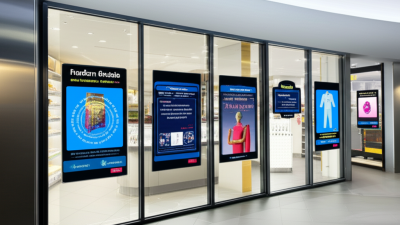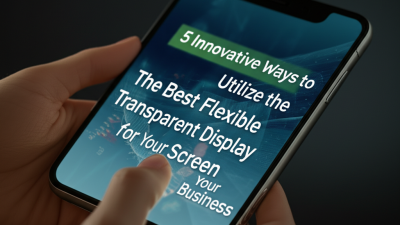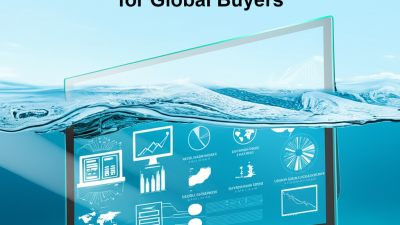
-
Home
-
Products
-
About Us
-
Case
-
News
-
BLOG
-
FAQ
-
Contact Us
Leave Your Message

In today's fast-paced world, the desire for innovation in design and technology has led to the emergence of dynamic solutions that transform our environments. Among these solutions, the Flexible Transparent Display Module stands out as a revolutionary tool that offers both aesthetic appeal and functional versatility. As we explore the integration of these modules into various spaces, from retail stores to home interiors, we will uncover how they serve to enhance user experience while providing a seamless blend of digital content and the physical environment. This technology not only paves the way for creative marketing strategies but also introduces a new dimension to spatial design, enabling the reimagining of traditional settings into interactive and immersive experiences. Thus, embracing Flexible Transparent Display Modules can serve as a catalyst for innovation, empowering businesses and individuals alike to rethink how we interact with our spaces.

The emergence of flexible transparent display modules represents a transformative opportunity for retail environments, allowing brands to engage customers in innovative ways. These displays can seamlessly integrate into store designs, enhancing visual merchandising without obstructing sightlines. Retailers can showcase dynamic content, from promotional videos to interactive product information, all while maintaining an open and inviting atmosphere. This adaptability not only captivates shoppers but also creates a unique shopping experience that stands out in a competitive market.
Moreover, the market potential for these displays is vast, driven by the increasing demand for personalized and immersive shopping experiences. Flexible transparent displays can be utilized for in-store displays, window advertising, and even augmented reality applications that provide shoppers with interactive product experiences. As technology continues to evolve, retail environments that adopt these modules can enhance customer engagement, increase dwell time, and ultimately drive sales. The ability to blend traditional retail aesthetics with cutting-edge technology positions flexible transparent displays as a pivotal innovation in the retail sector.
Transparent display technology is revolutionizing the way businesses engage with consumers. By integrating flexible transparent display modules into retail environments, companies can create dynamic and interactive spaces that captivate customers' attention. This innovation allows brands to convey messages and showcase products in a way that enhances user experience. As consumers become more visually oriented, the ability to provide a unique shopping environment through transparent displays can significantly influence their engagement levels, ultimately leading to higher sales conversion rates.
In this evolving landscape, leveraging tools like low-code platforms empowers businesses to swiftly design and deploy solutions tailored to their needs. The ability to develop custom applications allows organizations to analyze consumer interactions with transparent displays and derive actionable insights. This data can inform strategic decisions, optimize marketing efforts, and drive initiatives that improve customer engagement. Moreover, as the sales training market grows, the integration of new technologies, including transparent displays, presents opportunities for innovative training methods, enhancing the skill sets of sales teams to better connect with their audience.
The rapid advancements in technology have paved the way for flexible transparent display modules, primarily driven by OLED (Organic Light Emitting Diodes) and nanotechnology. OLED technology is renowned for its ability to create vibrant colors and deep contrasts on thin, lightweight surfaces. Unlike traditional display technologies, OLED can be manufactured on flexible substrates, allowing for innovative applications in various fields such as architecture, automotive design, and consumer electronics. This flexibility not only enhances aesthetic appeal but also opens new possibilities for interactive environments where displays can seamlessly integrate with surrounding structures.
Nanotechnology further amplifies the capabilities of flexible displays by enabling the creation of miniature components that enhance functionality. By manipulating materials at the molecular level, researchers can develop transparent conductive films and coatings that maintain performance while adding flexibility. This allows for the development of displays that can bend without loss of clarity or brightness. The combination of OLED and nanotechnology is revolutionizing how we perceive visual information, as these advancements lead to next-generation displays that are not only functional but also aesthetically transformative, fostering more engaging and immersive experiences in our daily lives.
| Feature | Traditional Displays | Flexible Transparent Displays | Benefits |
|---|---|---|---|
| Material | Glass/Plastic | OLED/Nanotechnology | Lightweight, Durable |
| Flexibility | Rigid | Highly Flexible | Adaptable to Various Surfaces |
| Transparency | Opaque | Transparent | Seamless Integration into Environments |
| Power Consumption | Higher | Lower | Energy Efficient |
| Application | Limited | Versatile | Wide Range of Uses |
Flexible transparent display modules are transforming various industries by combining functionality with aesthetics. In retail, for instance, a report by MarketsandMarkets indicates that the transparent display market is expected to grow from $1.8 billion in 2021 to $3.4 billion by 2026, reflecting a compound annual growth rate (CAGR) of 14.2%. High-profile brands like Dior have successfully leveraged these displays in store windows to enhance customer engagement, allowing consumers to interact with products in an immersive way while still seeing the physical merchandise behind the screen.
In the automotive sector, companies such as Hyundai are utilizing flexible transparent displays in their vehicles to provide drivers with augmented information without obstructing their view. According to a report from Allied Market Research, the global automotive display market, which includes transparent displays, is projected to reach $42 billion by 2027, growing at a CAGR of 9.5%. These displays not only enhance the driving experience but also contribute to vehicle safety by keeping critical information readily visible. Such innovations showcase the broad applicability of flexible transparent displays and their potential to enhance user experience across multiple environments.
The future of transparent display technologies is poised for tremendous growth, driven by innovations in iLED technology. As the market shifts towards more adaptive and immersive experiences, transparent displays are becoming increasingly relevant. These displays offer not only versatility in design but also the potential to transform various sectors, including retail, automotive, and smart buildings. With predictions of a CAGR of 7.1% and a dominant share in the APAC region, the transparent display market is on the brink of a significant evolution.
As industries seek to integrate advanced display solutions, micro-LEDs emerge as a frontrunner in this transition. Their attributes, such as high brightness and energy efficiency, align perfectly with the needs of future applications—ranging from augmented reality to innovative consumer electronics. Events like the recent TrendForce New Display Industry conference highlight the urgency for stakeholders to embrace these advancements. By investing in flexible transparent display modules, businesses can revolutionize their environments and meet the demand for cutting-edge visual experiences.





